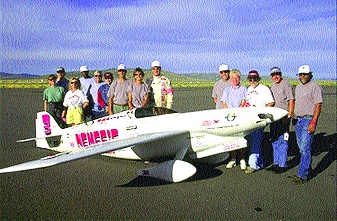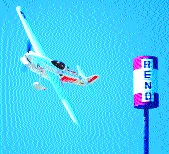By Connie Pardew
During EAA Oshkosh AirVenture 2000, the Nemesis, a record-breaking Formula One racer, made its last flight. Since then, Jon and Patricia Sharp have donated the aircraft to the Smithsonian National Air & Space Museum.
When the museum opens its new annex, the Steven F. Udvar-Hazy Center at Dulles International Airport in Northern Virginia, later this year, the Nemesis will take its place on display with more than 100 spacecraft and 180 aircraft.
After Nemesis’ retirement, the Sharps decided to dedicate their time and energy to building Nemesis NXT kit planes. The couple, along with a group of contract workers and volunteers, operates out of their hangar in Mojave.
The Nemesis NXT made its debut at the May 2002 Society of Advancement of Material and Processing Engineering convention in Long Beach, Calif. The kit plane weighs 1,200 pounds empty and 2,200 pounds loaded. High performance and precision crafted, the airplane should be able to reach a speed of 350 mph at sea level.
“The NXT is like Nemesis on steroids,” Sharp said. “Basically, it’s designed for the pilot to get from point A to point B—fast.”
Sharp, 52, a composites research engineer for Lockheed’s Skunk Works in Palmdale, Calif., says he got the racing bug as a young boy when he competed in go-kart, model airplane and drag racing. In his first air race, he placed fourth in a modified Cassutt 111M model, in Mexicali, Mexico, in 1978. In 1982 and 1986, Sharp and his Cassutt won the national championship races in Reno, Nev.
In 1989, he decided to devote all his vigor to a new all-composite model of his own design. He appeared two years later in Reno with the Sharp DSR-90. Since then, his team has been awarded four Pulitzer aviation trophies for breaking race records and three Bleriot medals awarded by the Federation Aeronautique International.
The Nemesis, which began its career in 1991, brought the racing team 16 world speed records and nine consecutive Reno National Air Race Gold Championships. In its nine consecutive wins, Nemesis averaged a speed of 244.68 mph.
This summer, Sharp plans to fly the NXT over the Mojave Desert. He also hopes to race again at the Reno National Championship Air Races in September. Plans are also in the works to fly the NXT at EAA Oshkosh AirVenture 2003.
Potential owners will use the plane for closed course and cross-country racing.
“The Nemesis team utilizes what’s called Perfect Fit Technology, which saves time for the assembler,” Sharp said. “It’s a process that make all the parts fit perfectly out of the box.”
The process is used on all windswept manufacturing breaks such as cowling upper/lower fuselage interface, canopy frame, access panels and doors, gear doors and slip flaps, said Sharp. The PFT controls step and gap size-down to one-thousandth-inch rather than one-sixteenth.
“It greatly reduces time on assembly by eliminating the steps of sanding and trimming,” he said.
The kit does not include power plant, props and avionics, but Sharp recommends the Teledyne Continental turbocharged 550 engine and the IO-550 N engines.
For more information, visit [http://www.nemesisnxt.com].














